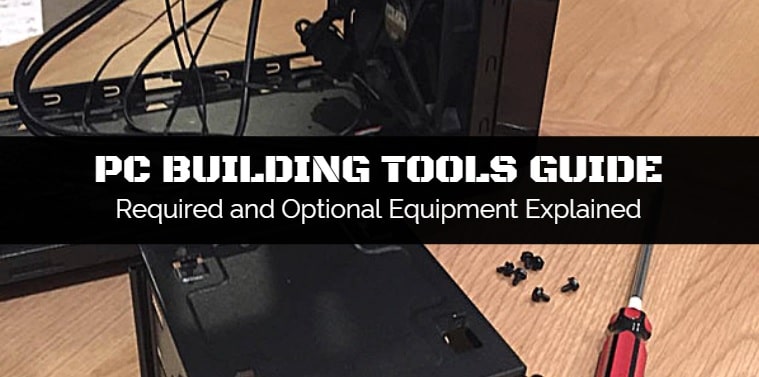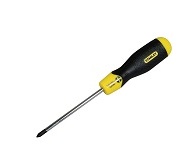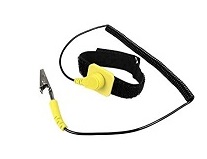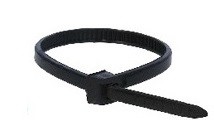Home > PC Assembly > Tools Needed
What Tools Do You Need to Build a Gaming PC?
The 5 Best PC Building Tools for DIY Computers (Required and Optional Tools)

In modern times, building your own desktop computer doesn’t require much at all in terms of tools or equipment, and a basic screwdriver is very likely to be all you actually need unless you're building something quite advanced like a custom open-loop liquid cooled PC.
We'll get to which screwdriver to use in a moment, but there are a bunch of other tools besides a screwdriver that are worth considering if you want to make things easier, or if you just want to be as prepared as possible because there are certain times when PC building will require another tool.
So, let's take a look at the 5 most common tools used for PC building, including our top value tool recommendations if you don't already have what you need lying around the house or backyard somewhere. We'll also wrap up the guide with a FAQ covering any other things to know in relation to PC building tools and equipment.
Related: How to Build a Computer from Scratch
1. Screwdriver

Is a screwdriver all you need to build a PC?
In the vast majority of cases (pun intended) - yes, a basic screwdriver is the only required tool to build a computer (however you may need 2 different sizes; see below). You'll use it to tighten the screws on your components to hold them securely in place. For a typical modern gaming PC build, I'd go as far to say that 95% of the time a screwdriver is all you need and you'd only need other tools if you're doing rarer customizations or if you want to make things more convenient.
What type of screwdriver should you use to build a PC?
A Phillips-head size number #2 is needed for every PC build, as pretty much all screws inside a computer are going to be crosshead ones. You ideally want one with a decently-long neck for those hard to reach screws, but you could get away with a small-neck screwdriver in most cases. If you had to choose, you're better off with one that's longer than you need instead of shorter.
As well as a #2 size head screwdriver, if you're installing a M.2 SSD (the storage drives that slot into your motherboard), you also need a size #1 head Phillips-head screwdriver as well. The screws that secure an M.2 drive to a motherboard are smaller than regular computer screws.
Is a magnetic screwdriver safe to use when building a PC?
A magnetic screwdriver (one with a magnetic tip) is very handy to avoid dropping small screws in small, dark, hard to reach places during installation (which can be a little annoying). But if you're worried because you perhaps heard somewhere that a magnetic screwdriver could potentially cause harm to your PC components - relax.
Unless you have an ancient floppy disk drive in your system (if you still do these days that's certainly quite the achievement) the magnet isn't going to be strong enough to do damage to modern components. But technically speaking, there is a very-little-minuscule-rare chance of a possibility, so if you want to stay extra safe then keep the magnetic bit of the screwdriver away from open circuitry within your build, and away from your storage drives.
Best value screwdriver for PC building
If you don't have a spare screwdriver laying around your house somewhere, below is the one I'd get at a good price: (and don't forget to get a size #1 head screwdriver as well if you have a M.2 SSD)
Phillips Screwdriver QM-STVR 12 Inch Screwdriver (Magnetic Tip, Cross Head Number 2)
2. Anti-Static Wrist Strap

What is an Anti-Static Wrist Strap?
An anti-static wrist strap (or band) is a bracelet-type device you wear on your wrist which connects to an electric socket, and if any electrical charge builds up between you and your hardware components, the charge is safety dissipated through to the socket (avoiding a spark and potentially causing damage to your parts).
Do You Need an Anti-static Wrist Strap?
The thing is, while a wearable anti-static device is conveninent and the simplest, easier way to discharge any electrical build up, it's not necessary as you can avoid electrical risks by simply grouding yourself instead (by regularly touching metal objects such as your case during installation, and especially right before you go to handle a component).
But if you want to be extra careful with static electricity, either because you want to reduce the risk of damaging components to zero (perhaps you're worried you'll forget to ground yourself manually), or if you don’t have a choice but to build your PC in an area with extra potential for static electricity build up such as carpet or very dry areas, it's a good idea to invest in a strap.
They’re cheaper than other anti-static equipment like anti-static mats (see the FAQ below) and will give you peace of mind, especially as a first-time builder who may be a little worried. But again - they're totally optional so it's up to you really. If you want a good value anti-static wrist strap, this is the one I would get:
Recommended Anti-static Wrist Strap for PC Building:
Rosewill RTK-002 Anti Static Wrist Strap Band
3. Cable or Twist Ties

Cable ties (also called zip ties) and twist ties are used to tie up any loose cables lying around in your case which not only makes your finished build look neater, but promotes better airflow within your case. Most modern computer cases will come shipped with a bunch of cable/zip ties though, so chances are you won't need to buy any more.
You could also use Velcro straps instead, but cable/twist ties are best as Velcro will take up more space.I'd also favor using cable/zip ties vs twist ties, because twist ties have a bare metal core which have the potential to scratch (or even short-circuit) something. Lastly, it's important that you don't fit these too tight around your cables as you could damage them. To cut the ends of your ties once you've fitted one you can simply use sharp scissors, or needle-nose pliers (see below).
4. Flashlight (or Lamp)
Depending on where you're building your computer you may need an extra light source to see exactly what you're doing when working within your case. Some PC cases really do their best to block out light, even if you’re in a well-lit room, so if you need to brighten things up you could use a flashlight (or just use your mobile phone) however this is far from ideal as you’ll have to hold it in one hand while trying to hold your hardware in the other. Not good, and a recipe for a more difficult installation.
A better option would be a lamp that has an adjustable neck that you can place beside your build and angle right inside of your case. Even better would be a headlamp, which may feel a little over the top but would be most convenient and frees up both your hands to properly handle your components with care and work your magic. But for most builders, give the headlamp a miss because it's likely more overkill than an RTX 2080 for 1080p 60Hz.

Hardcore mode activated
5. Needle-Nose Pliers
Rarely necessary but handy to have for various situations. You could use pliers for loosening up screws or bolts that are super-tight, picking up hard to reach screws that you may drop within your case, removing chipped/broken screws, removing motherboard standoffs, and cutting zip ties. Speaking of loose screws; always remove them if you drop them inside your build, as though you'd have to be super unlucky for this to happen, they do pose the possibility of causing an electrical shortage.

PC Tools FAQ
What About Thermal Paste?
The majority of CPU coolers you buy will already come with some thermal paste pre-applied (including Intel and AMD stock coolers), and for most people that's good enough. But if you want to ensure you're using the highest-quality, freshest thermal paste for your CPU to run as efficiency as possible (most pre-applied paste is going to be decent quality but you never know) then consider removing the paste and applying your own high-quality paste instead because you can find top-notch quality paste for cheap (and a small tub will last a long time unless you build for a living). Can't go wrong with Arctic's cult-status MX-4.
Best Thermal Paste: Arctic MX-4
Using Rubbing Alcohol to Remove Old Thermal Paste
Also, to remove old thermal paste you should use a rubbing alcohol that is strong enough to remove all grime and dirt, but it also evaporates real quick (and without causing any corrosion) within seconds (though wait a minute to be safe). Using a product rated 70% is fine, as higher ones like 99% will simply dry quicker, but 70% will still only take seconds so it doesn't matter.
What About a Hex Driver?
A hex driver could come in handy for hexagonal motherboard standoff screws, or screws for some CPU coolers, but the reality is standoffs rarely need to be taken out or installed these days.
What About Anti-Static Mats?
Instead of using an anti-static wrist band to safely eliminate any ESD (electro-static discharge), you could use an anti-static mat to build your PC on instead which allows for unrestricted movement if you don't care about being cost-effective (mats can be quite a bit more expensive than just getting a strap).
Best Budget Anti-Static Mat: StarTech 24x27.5in Beige Desktop Anti-Static Mat (M3013)

Best High-End Anti-Static Mat: ModRight Xtreme Super Large Anti-Static (47" x 23")

Best PC Building Toolkits
If you want to be as prepared as possible for all your future builds and upgrades, nothing beats a good toolkit. These are the ones we can recommend for PC builders at various price points.
StarTech 19 Piece Computer Toolkit (Budget)
iFixit Pro Tech Toolkit (Mid Range)
Rosewill RTK-146 Computer Toolkit (Premium)
Trusted VPN
VPN software can be important in this day and age, especially if you do lots of online banking and/or use public WiFi whilst travelling. Having a VPN adds an extra layer of security to your PC or laptop when online to help protect your data, passwords, financials, etc from hackers or malicious programs. It can also let you access region-locked content (eg US Netflix from overseas). For gamers their can be even more benefits to using a VPN.
Because they're so popular these days, there are countless VPN providers, and it can be confusing to pick one. If you want my 2 cents, after a lot of research I decided on NordVPN 'cause it's one of the fastest, most reliable VPNs for both gaming and general use, with a lot of credible reviews out there backing that up. They also quite often run very solid deals.
Popular Articles (see all)
Search the Site
About the Author (2025 Update)
I'm an indie game developer currently very deep in development on my first public release, a highly-immersive VR spy shooter set in a realistic near-future releasing on Steam when it's ready. The game is partly inspired by some of my favorites of all time including Perfect Dark, MGS1 and 2, HL2, Splinter Cell, KOTOR, and Deus Ex (also movies like SW1-6, The Matrix, Bladerunner, and 5th Element).
Researching, writing, and periodically updating this site helps a little with self-funding the game as I earn a few dollars here and there from Amazon's affiliate program (if you click an Amazon link on this site and buy something, I get a tiny cut of the total sale, at no extra cost to you).
Hope the site helps save you money or frustration when building a PC, and if you want to support the countless hours gone into creating and fine-tuning the many guides and tutorials on the site, besides using my Amazon links if purchasing something, sharing an article on socials or Reddit does help and is much appreciated.

